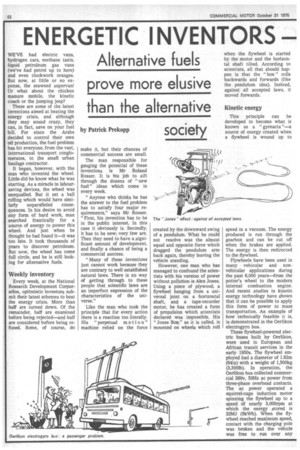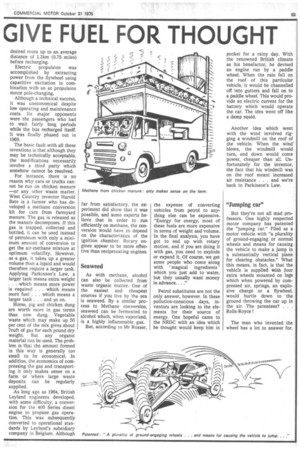ENERGETIC INVENTORS GIVE FUEL FOR THOUGHT
Page 54

Page 55

If you've noticed an error in this article please click here to report it so we can fix it.
Alternative fuels prove more elusive than the alternative
by Patrick Prekopp
WE'VE had electric vans, hydrogen cars, methane taxis, liquid petroleum gas vans (we've had petrol up to here) and even clockwork oranges. But now, at little or no expense, the seaweed supervan! Or what about the chicken manure =bile, the kinetic coach or the jumping jeep?
These are some of the latest inventions aimed at beating the energy crisis, and although they may sound crazy, they can, in fact, save on your fuel bill. For since the Arabs decided to control their own oil production, the fuel problem has hit everyone, from the vast, international transport conglomerates, to the small urban haulage contractor.
It began, however, with the man who invented the wheel. Little did he know what he was starting. As a miracle in laboursaving devices, the wheel was unequalled. But it set a ball rolling which would have similarly unparalleled consequences. In his desire to avoid any form of hard work, man searched frantically for a source of energy to power this wheel. And just when he thought he had found it—it was too late. It took thousands of years to discover petroleum. But now, the wheel has come full circle, and he is still looking for alternative fuels.
Weekly inventory
Every week, at the National Research Development Corporation, optimistic inventors submit their latest schemes to beat the energy crisis. More than half are turned down. Of the remainder, half are examined before being rejected—and half are considered before 'being refused. Some, of course, do make it, but their chances of commercial success are small.
The man responsible for gauging the potential of these inventions is Mr Roland Rosser. It is his job to sift through the dozens of "new fuel" ideas which come in every week.
"Anyone who thinks he has the answer to the fuel problem has to satisfy four major requirements," says Mr Rosser. "First, his invention has to be in the public interest. In this case it obviously is. Secondly, it has to be new; .very few are. Then they need to have a significant amount of development, and finally a chance of being a commercial success.
"Many of these inventions just cannot work because they are contrary to well established natural laws. There is no way of getting through to these people that scientific laws are an imperfect expression of the characteristics of the universe."
Like the man who took the principle that for every action there is a reaction too literally. His "perpetual motion" machine relied on the force created by the downward swing of a pendulum. What he could not resolve was the almost equal and opposite force which dragged the pendulum arm back again, thereby leaving the vehicle standing.
However, one man who has managed to confound the scientists with his version of power without pollution is Alex Jones. Using a piece of plywood, a flyWheel hanging from a universal joint on a horizontal shaft, and a tape-recorder motor, he has created a form of propulsion which scientists declared was impossible. His "Jones Box" as it is called, is mounted on wheels which roll when the flywheel is started by the motor and the horizontal shaft tilted. According to scientists, all that should happen is that the "box " rolls backwards and forwards (like the pendulum idea). Instead, against all accepted laws, it moved forwards.
Kinetic energy
This principle can be developed to become what is known as a " gyreacta "—a source of energy created when a ,flywheel is wound up to speed in a vacuum. The energy produced is run through the gearbox and can be cut off when the brakes are applied. The energy is then redirected to the flywheel.
Flywheels have been used in many vehicular and nonvehicular applications during the past 6,000 years—from the potter's wheel to the modern internal combustion engine. And recent studies in kinetic energy technology have shown that it can be possible to apply this form of power to mass transportation. An example of how technically feasible it is, is demonstrated in the Oerlikon electrogyro bus.
These flywheel-powered electric buses built by Oerlikon, were used in European and African transit services in the early 1950s. The flywheel employed had a diameter of 1.62m (64in) with a weight of 1,500kg (3,300Ib). In operation, the Oerlikon bus collected commercial 360v, 50Hz ac power from three-phase overhead contacts. The ac power operated a squirrel-cage induction motor spinning the flywheel up to a speed of nearly 3,000rpm at Which the energy stored is 32MJ (9kWh). When the flywheel reached maximum speed, contact with the Charging pole was broken and 'the vehicle was free to run over any desired route up to an average distance of 1.2km (0.75 miles) before recharging.
Electric propulsion was accomplished by extracting power from the flywheel using capacitive excitation in combination with an ac propulsion motor pole-changing.
Although a 'technical success, it was uneconomical despite low operating and maintenance costs. Its major opponents were the passengers who had to wait fairly long periods while the bus recharged itself. It was finally phased out in 1969.
The basic fault with all these inventions is that although they may be technically acceptable, the modifications necessarily involve a third party which somehow cannot be resolved.
For instance, there is no reason why cars or trucks cannot be run on chicken manure —or any other waste matter. West Country inventor Harold Bate is a farmer who has developed a methane conversion kit •for cars from farmyard manure. The gas is released as the manure decomposes. If this gas is trapped, collected and bottled, it can be used instead of petroleum with only a minimum amount of conversion to get the air-methane mixture at optimum volatility. However, as a gas, it takes up a greater volume than a liquid and would therefore require a larger tank. Applying Parkinson's Law, a larger tank means extra weight . . . which means more power is required . Which means more fuel . . . which means a larger tank . . . and so on.
Horse, pig and chicken dung are worth more in gas terms than cow dung. Vegetable waste which may make up 50 per cent of the mix gives about 7cuft of gas for each pound dry weight. But any organic material can 'be ,used. The problem is that the amount formed in this way is generally too small to be economical. In addition, the economics of compressing the gas and transporting it only makes sense on a farm or where large waste deposits can be regularly supplied.
As long ago as 1964, British Leyland engineers developed, with some difficulty, a conversion for the 400 Series diesel engine to propane gas operation. This was subsequently converted to operational standards by Leyland's subsidiary company in Belgium. Although far from satisfactory, the experiment did show that it was possible, and some experts believe that in order to run efficiently on methane, the conversion would have to depend on the characteristics of the ignition chamber. Rotary engines appear to be more effective than reciprocating engines.
Seaweed
As with methane, alcohol can also be collected from waste organic matter. One of the easiest and cheapest sources if you live by the sea is seaweed. By a similar process to Methane conversion, seaweed can be fermented to alcohol which, when vaporised., is a highly inflammable gas.
But, according to Mr Rosser, the expense of converting vehicles from petrol to anything else can be expensive. "Energy for energy, most of these fuels are more expensive in terms of weight and volume. In the final analysis, you have got to end up with rotary motion, and if you are doing it with gas, you need to explode or expand it. Of course, we get some people who come along with 'magical ingredients' which you just add to water, but they usually want money in advance...."
• Petrol substitutes are not the only answer, however. In these pollution-conscious days, inventors are looking to the elements for their source of energy. One hopeful came to the NRDC with an idea which he thought would keep him in pocket for a rainy day. With the renowned British climate as his benefactor, he devised an engine run by a paddle wheel. When the rain fell on the roof of this particular vehicle, it would be channelled off into gutters and fall on to a paddle wheel. This would provide an electric current for the battery which would operate the car. The idea went off like a damp squid.
Another idea which went with the wind involved rigging a windmill on the roof of the vehicle. When the wind' blows, the windmill would turn, and down would come power, cheaper than' all. Unfortunately for the inventor, the fact that his windmill was on the roof meant increased air resistance . . . and we're back to Parkinson's Law.
"Jumping car", But they're not all mad professors. One highly respected motor company has patented the "jumping car." Filed as a motor vehicle with "a plurality of ground-engaging or normal wheels and means for causing the vehicle to make a jump in a substantially vertical plane for clearing obstacles." What this means, in fact, is that the vehicle is supplied with four extra wheels mounted on legs which when powered by compressed air, springs, an explosive charge or a flywheel, would hurtle down to the ground throwing the car up in the air. The patentees? . . . Rolls-Royce The man who invented the wheel has a lot to answer for.
































































































